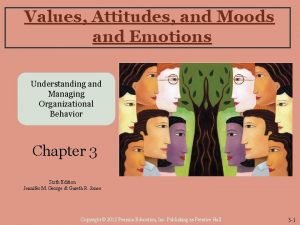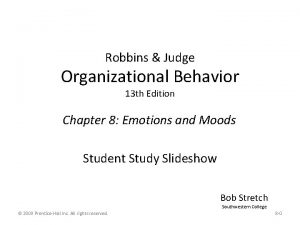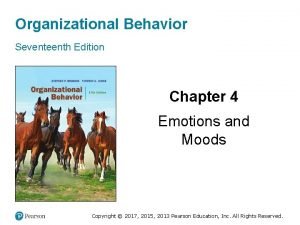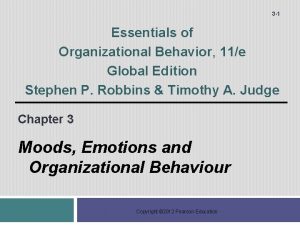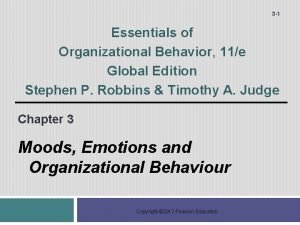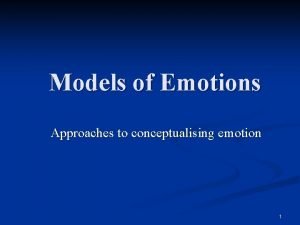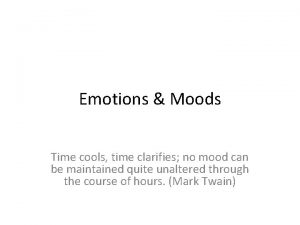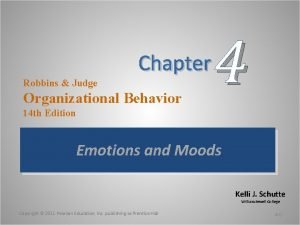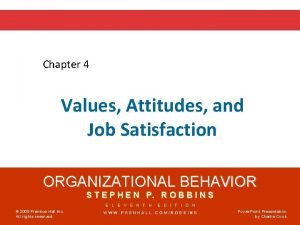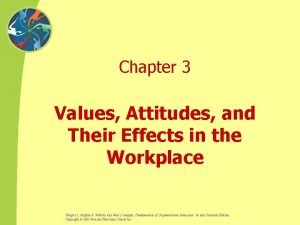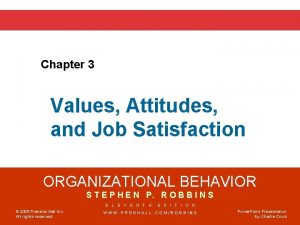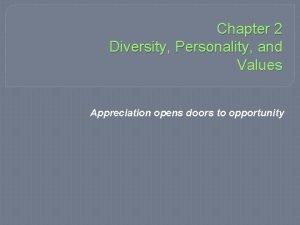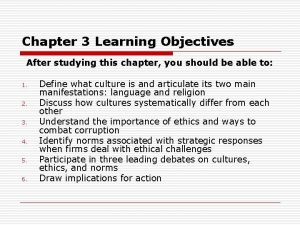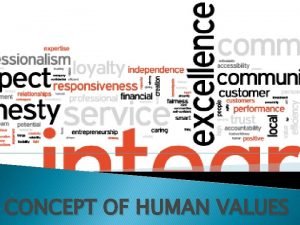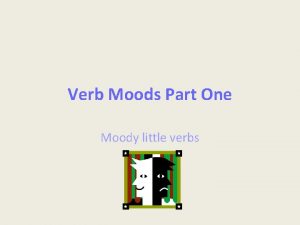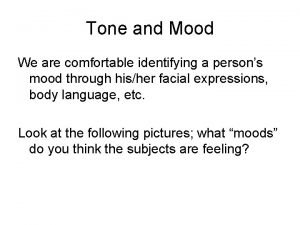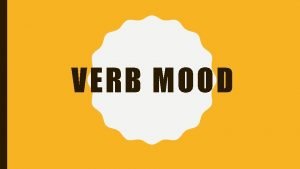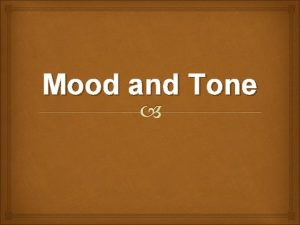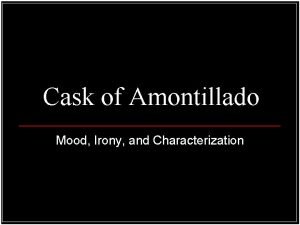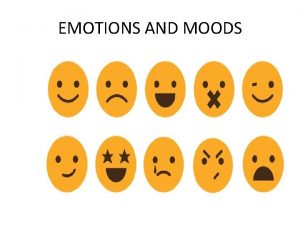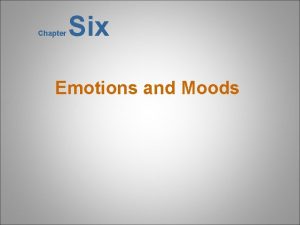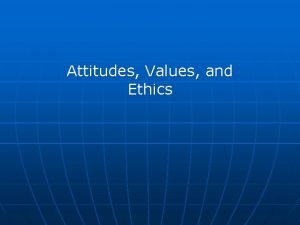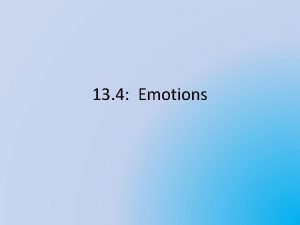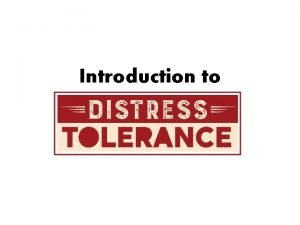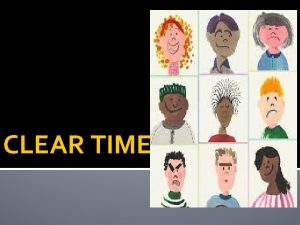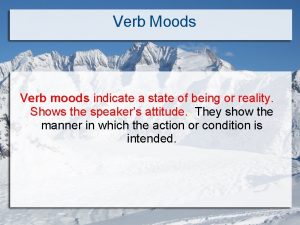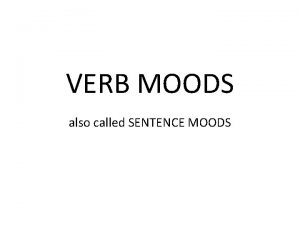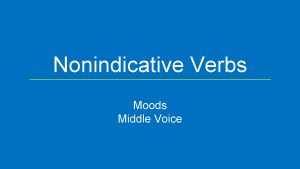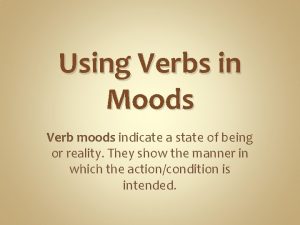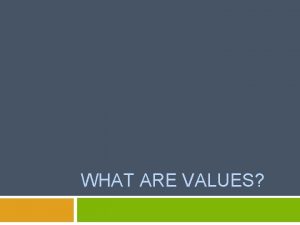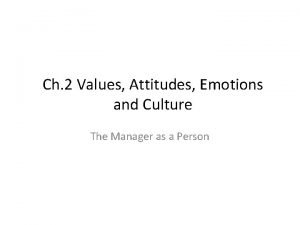Values Attitudes and Moods and Emotions Understanding and



































- Slides: 35

Values, Attitudes, and Moods and Emotions Understanding and Managing Organizational Behavior Chapter 3 Sixth Edition Jennifer M. George & Gareth R. Jones Copyright © 2012 Pearson Education, Inc. Publishing as Prentice Hall 3 -1

Learning Objectives Describe the nature of work values and ethical values and why they are of critical importance in organizations Understand why it is important to understand employees’ moods and emotions on the job Appreciate when and why emotional labor occurs in organizations Copyright © 2012 Pearson Education, Inc. Publishing as Prentice Hall 3 -2

Learning Objectives Describe the nature, causes, theories, and consequences of job satisfaction Appreciate the distinction between affective commitment and continuance commitment and their implications for understanding organizational behavior Copyright © 2012 Pearson Education, Inc. Publishing as Prentice Hall 3 -3

Opening Case: Family owned Business How can a company maintain high levels of employee satisfaction in an industry known for high levels of turnover? Nugget Market is a family owned business that strives to treat their employees with respect. Copyright © 2012 Pearson Education, Inc. Publishing as Prentice Hall 3 -4

The Nature of Values are one’s personal convictions about what one should strive for in life and how one should behave Work Values Ethical Values Copyright © 2012 Pearson Education, Inc. Publishing as Prentice Hall 3 -5

Values in the Workplace Exhibit 3. 1 Values Work Values Intrinsic Work Values Extrinsic Work Values Ethical Values Justice Values Utilitarian Values Copyright © 2012 Pearson Education, Inc. Publishing as Prentice Hall Moral Rights Values 3 -6

A Comparison of Intrinsic and Extrinsic Work Values Extrinsic Values Intrinsic Values High pay Interesting work Job security Challenging work Job benefits Learning new things Status in wider community Making important Social contacts Time with family Time for hobbies contributions Responsibility and autonomy Being creative Copyright © 2012 Pearson Education, Inc. Publishing as Prentice Hall 3 -7

Code of Ethics A code of ethics is a set of formal rules and standards, based on ethical values and beliefs about what is right and wrong, that employees can use to make appropriate decisions when the interests of other individuals or groups are at stake Whistleblowers Copyright © 2012 Pearson Education, Inc. Publishing as Prentice Hall 3 -8

Work Attitudes Work attitudes are collections of feelings, beliefs, and thoughts about how to behave that people currently hold about their jobs and organizations Job Satisfaction Organizational Commitment Copyright © 2012 Pearson Education, Inc. Publishing as Prentice Hall 3 -9

Components of Work Attitudes Exhibit 3. 3 Affective Component Cognitive Component Work Attitudes Behavioral Component Copyright © 2012 Pearson Education, Inc. Publishing as Prentice Hall 3 -10

Work Moods How people feel at the time they actually perform their jobs More transitory than values and attitudes Determining factors: Personality Work situation Circumstances outside of work Copyright © 2012 Pearson Education, Inc. Publishing as Prentice Hall 3 -11

Work Moods Positive Negative Excited Distressed Enthusiastic Fearful Active Scornful Strong Hostile Peppy Jittery Elated Nervous Copyright © 2012 Pearson Education, Inc. Publishing as Prentice Hall 3 -12

Emotions Intense, short-lived feelings that are linked to specific cause or antecedent Emotions can feed into moods Emotional labor Copyright © 2012 Pearson Education, Inc. Publishing as Prentice Hall 3 -13

Emotional Labor Display Rules Feeling Rules Expression Rules Copyright © 2012 Pearson Education, Inc. Publishing as Prentice Hall 3 -14

Values, Attitudes, Moods, and Emotions Exhibit 3. 4 Values Attitudes (most stable) (moderately stable) Moods and Emotions (most changing) Copyright © 2012 Pearson Education, Inc. Publishing as Prentice Hall 3 -15

Determinants of Job Satisfaction Exhibit 3. 5 Personality Work Situation Job Satisfaction Values Social Influence Copyright © 2012 Pearson Education, Inc. Publishing as Prentice Hall 3 -16

Determinants of Job Satisfaction_1 Personality Extraverts tend to have higher levels of job satisfaction than introverts Values A person with strong intrinsic work values is more likely than one with weak intrinsic work values to be satisfied with a job that is meaningful but requires long hours and offers poor pay Copyright © 2012 Pearson Education, Inc. Publishing as Prentice Hall 3 -17

Determinants of Job Satisfaction_2 Work Situation tasks a person performs people a jobholder interacts with surroundings the in which a person works way the organization treats the jobholder Copyright © 2012 Pearson Education, Inc. Publishing as Prentice Hall 3 -18

Determinants of Job Satisfaction_3 Social influence is the influence that individuals or groups have on a person’s attitudes and behavior Coworkers Family Other reference groups (unions, religious groups, friends) Culture Copyright © 2012 Pearson Education, Inc. Publishing as Prentice Hall 3 -19

Theories of Job Satisfaction The Facet Model Herzberg’s Motivator-Hygiene Theory The Discrepancy Model The Steady-State Theory Copyright © 2012 Pearson Education, Inc. Publishing as Prentice Hall 3 -20

The Facet Model Independence Ability utilization Moral values Achievement Recognition Activity Responsibility Advancement Security Authority Social service Company policies Social status Compensation Variety Coworkers Working conditions Creativity Copyright © 2012 Pearson Education, Inc. Publishing as Prentice Hall 3 -21

Herzberg’s Motivator-Hygiene Theory of Job Satisfaction Focuses on the effects of certain types of job facets Everyone has two sets of needs or requirements Motivator Needs Hygiene Needs Copyright © 2012 Pearson Education, Inc. Publishing as Prentice Hall 3 -22

Motivator and Hygiene Needs When motivator needs are met, workers will be satisfied; when these needs are not met, workers will not be satisfied. When hygiene needs are met, workers will not be dissatisfied; when these needs are not met, workers will be dissatisfied. Copyright © 2012 Pearson Education, Inc. Publishing as Prentice Hall 3 -23

Two Views of Job Satisfaction Exhibit 3. 7 Copyright © 2012 Pearson Education, Inc. Publishing as Prentice Hall 3 -24

The Discrepancy Model of Job Satisfaction To determine how satisfied they are with their jobs, workers compare their job to some “ideal job. ” This “ideal job” could be What one thinks the job should be like What one expected the job to be like What one wants from a job What one’s former job was like Can be used in combination with the Facet Model. Copyright © 2012 Pearson Education, Inc. Publishing as Prentice Hall 3 -25

Determining Satisfaction with the Discrepancy and Facet Models A) How much (enter job facet) do you currently have at your job? B) How much (enter job facet) do you think your job should have? The difference between A and B indicates the level of satisfaction with that facet The differences are summed for an overall satisfaction score Copyright © 2012 Pearson Education, Inc. Publishing as Prentice Hall 3 -26

The Steady-State Theory of Job Satisfaction Each worker has a typical or characteristic level of job satisfaction, called the steady state or equilibrium level. Different situational factors or events at work may move a worker temporarily from this steady state, but the worker will eventually return to his or her equilibrium level. Copyright © 2012 Pearson Education, Inc. Publishing as Prentice Hall 3 -27

Job Satisfaction as a Steady State Exhibit 3. 8 Copyright © 2012 Pearson Education, Inc. Publishing as Prentice Hall 3 -28

Sample Measures of Job Satisfaction Exhibit 3. 9 Copyright © 2012 Pearson Education, Inc. Publishing as Prentice Hall 3 -29

Consequences of Job (Dis)Satisfaction Performance Absenteeism Turnover Copyright © 2012 Pearson Education, Inc. Publishing as Prentice Hall 3 -30

Determinants of Absence from Work Exhibit 3. 10 Ability to attend work Motivation to attend is affected by work is affected by Illness and accidents Job satisfaction Transportation problems Family responsibilities Organization’s absence policy Other factors Copyright © 2012 Pearson Education, Inc. Publishing as Prentice Hall 3 -31

Mobley’s Model of the Turnover Process Exhibit 3. 11 Copyright © 2012 Pearson Education, Inc. Publishing as Prentice Hall 3 -32

Consequences of Job Satisfaction Organizational Citizenship Behavior (OCB) Employee Well-Being Copyright © 2012 Pearson Education, Inc. Publishing as Prentice Hall 3 -33

Organizational Commitment Feelings and beliefs about the employing organization as a whole Affective commitment Continuance commitment Affective commitment is more positive for organizations than continuance commitment Copyright © 2012 Pearson Education, Inc. Publishing as Prentice Hall 3 -34

. This work is protected by United States copyright laws and is provided solely for the use of instructors in teaching their courses and assessing student learning. Dissemination or sale of any part of this work (including on the Worldwide Web) will destroy the integrity of the work and is not permitted. The work and materials from it should never be made available to students except by instructors using the accompanying text in their classes. All recipients of this work are expected to abide by these restrictions and to honor the intended pedagogical purposes and the needs of other instructors who rely on these materials. All rights reserved. No part of this publication may be reproduced, stored in a retrieval system, or transmitted, in any form or by any means, electronic, mechanical, photocopying, recording or otherwise, without the prior written permission of the publisher. Printed in the United States of America. Copyright © 2012 Pearson Education, Inc. Publishing as Prentice Hall 3 -35
 Emotions and attitudes in a workplace
Emotions and attitudes in a workplace Emotions and moods in organizational behavior
Emotions and moods in organizational behavior Emotions and moods in organizational behavior
Emotions and moods in organizational behavior Emotions and moods in organizational behavior
Emotions and moods in organizational behavior Emotions and moods in organizational behavior
Emotions and moods in organizational behavior Tendency to be careful scrupulous and persevering
Tendency to be careful scrupulous and persevering Circumplex model of emotion
Circumplex model of emotion Ob applications of emotions and moods
Ob applications of emotions and moods Ob applications of emotions and moods
Ob applications of emotions and moods Ob applications of emotions and moods
Ob applications of emotions and moods Workplace emotions, attitudes, and stress
Workplace emotions, attitudes, and stress Workplace emotions, attitudes, and stress
Workplace emotions, attitudes, and stress Nz attitudes and values study
Nz attitudes and values study Values attitudes and job satisfaction
Values attitudes and job satisfaction Values and attitudes in the workplace
Values and attitudes in the workplace Values attitudes and job satisfaction
Values attitudes and job satisfaction Machiavellian personality
Machiavellian personality An individual's enduring tendency to feel
An individual's enduring tendency to feel Western vs eastern values
Western vs eastern values A bit can have two possible values. what value are those?
A bit can have two possible values. what value are those? Concept of human value
Concept of human value Drug that alters moods, thoughts, and sense perceptions
Drug that alters moods, thoughts, and sense perceptions Poems with mood and tone
Poems with mood and tone Drugs that alter moods thoughts and sense perceptions
Drugs that alter moods thoughts and sense perceptions A chemical substance that alters perception and mood
A chemical substance that alters perception and mood Examples of interrogative mood
Examples of interrogative mood Tone vs mood
Tone vs mood Positive moods
Positive moods Literary mood examples
Literary mood examples Diction definition poetry
Diction definition poetry Mood sentences
Mood sentences Example of tone
Example of tone Mood descriptors
Mood descriptors The cask of amontillado mood examples
The cask of amontillado mood examples Etre verbs
Etre verbs Se lever conjugation
Se lever conjugation
